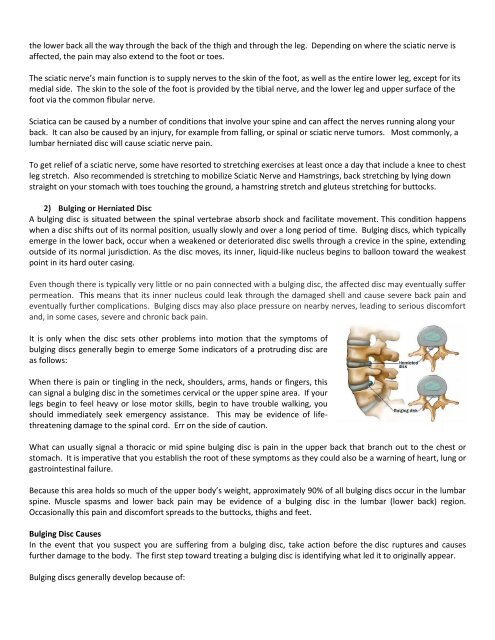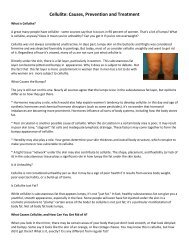Back Pain Cause and Relief
http://www.mb103.com/lnk.asp?o=10166&c=918271&a=175302&l=9956 Back Pain Cause and Relief
http://www.mb103.com/lnk.asp?o=10166&c=918271&a=175302&l=9956
Back Pain Cause and Relief
You also want an ePaper? Increase the reach of your titles
YUMPU automatically turns print PDFs into web optimized ePapers that Google loves.
the lower back all the way through the back of the thigh <strong>and</strong> through the leg. Depending on where the sciatic nerve is<br />
affected, the pain may also extend to the foot or toes.<br />
The sciatic nerve’s main function is to supply nerves to the skin of the foot, as well as the entire lower leg, except for its<br />
medial side. The skin to the sole of the foot is provided by the tibial nerve, <strong>and</strong> the lower leg <strong>and</strong> upper surface of the<br />
foot via the common fibular nerve.<br />
Sciatica can be caused by a number of conditions that involve your spine <strong>and</strong> can affect the nerves running along your<br />
back. It can also be caused by an injury, for example from falling, or spinal or sciatic nerve tumors. Most commonly, a<br />
lumbar herniated disc will cause sciatic nerve pain.<br />
To get relief of a sciatic nerve, some have resorted to stretching exercises at least once a day that include a knee to chest<br />
leg stretch. Also recommended is stretching to mobilize Sciatic Nerve <strong>and</strong> Hamstrings, back stretching by lying down<br />
straight on your stomach with toes touching the ground, a hamstring stretch <strong>and</strong> gluteus stretching for buttocks.<br />
2) Bulging or Herniated Disc<br />
A bulging disc is situated between the spinal vertebrae absorb shock <strong>and</strong> facilitate movement. This condition happens<br />
when a disc shifts out of its normal position, usually slowly <strong>and</strong> over a long period of time. Bulging discs, which typically<br />
emerge in the lower back, occur when a weakened or deteriorated disc swells through a crevice in the spine, extending<br />
outside of its normal jurisdiction. As the disc moves, its inner, liquid-like nucleus begins to balloon toward the weakest<br />
point in its hard outer casing.<br />
Even though there is typically very little or no pain connected with a bulging disc, the affected disc may eventually suffer<br />
permeation. This means that its inner nucleus could leak through the damaged shell <strong>and</strong> cause severe back pain <strong>and</strong><br />
eventually further complications. Bulging discs may also place pressure on nearby nerves, leading to serious discomfort<br />
<strong>and</strong>, in some cases, severe <strong>and</strong> chronic back pain.<br />
It is only when the disc sets other problems into motion that the symptoms of<br />
bulging discs generally begin to emerge Some indicators of a protruding disc are<br />
as follows:<br />
When there is pain or tingling in the neck, shoulders, arms, h<strong>and</strong>s or fingers, this<br />
can signal a bulging disc in the sometimes cervical or the upper spine area. If your<br />
legs begin to feel heavy or lose motor skills, begin to have trouble walking, you<br />
should immediately seek emergency assistance. This may be evidence of lifethreatening<br />
damage to the spinal cord. Err on the side of caution.<br />
What can usually signal a thoracic or mid spine bulging disc is pain in the upper back that branch out to the chest or<br />
stomach. It is imperative that you establish the root of these symptoms as they could also be a warning of heart, lung or<br />
gastrointestinal failure.<br />
Because this area holds so much of the upper body’s weight, approximately 90% of all bulging discs occur in the lumbar<br />
spine. Muscle spasms <strong>and</strong> lower back pain may be evidence of a bulging disc in the lumbar (lower back) region.<br />
Occasionally this pain <strong>and</strong> discomfort spreads to the buttocks, thighs <strong>and</strong> feet.<br />
Bulging Disc <strong>Cause</strong>s<br />
In the event that you suspect you are suffering from a bulging disc, take action before the disc ruptures <strong>and</strong> causes<br />
further damage to the body. The first step toward treating a bulging disc is identifying what led it to originally appear.<br />
Bulging discs generally develop because of:












